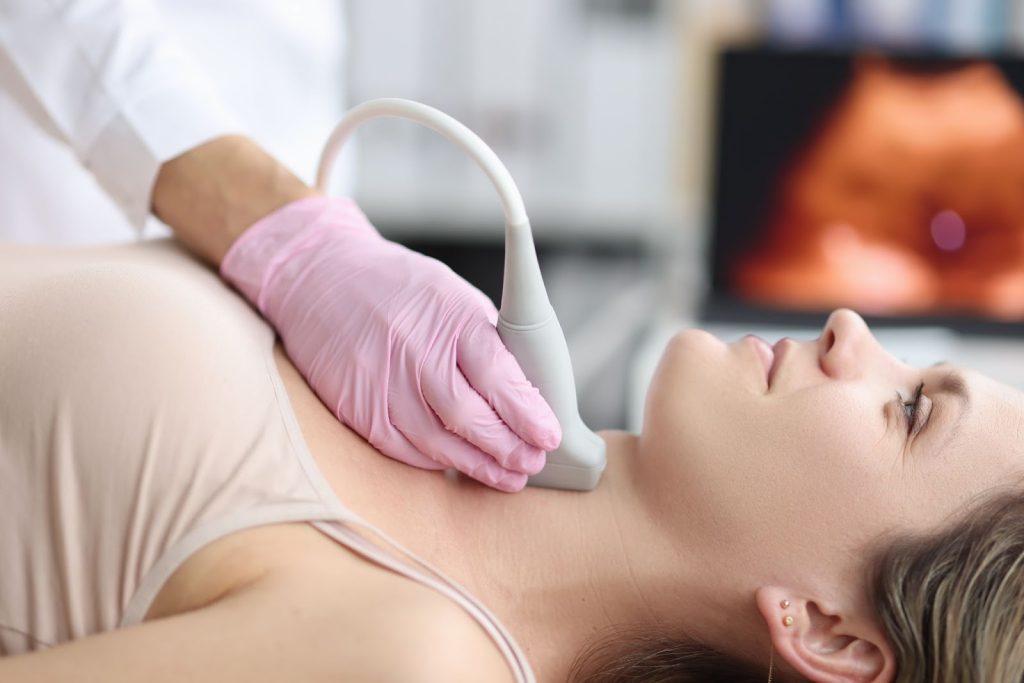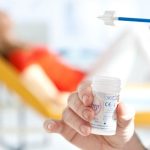
During a neck lymph node  biopsy, your doctor uses an ultrasound
biopsy, your doctor uses an ultrasound  scanner to help them take a small amount of lymph node tissue using a fine needle.
scanner to help them take a small amount of lymph node tissue using a fine needle.
Ultrasound scans use high frequency sound waves to create a picture of a part of the body. The ultrasound scanner has a probe that gives off sound waves. The sound waves bounce off the structures inside your body, and the probe picks them up. The probe links to a computer that turns the sound waves into a picture.
You normally have this test as an outpatient procedure in the hospital’s imaging department.
Why do I need a neck lymph node ultrasound and biopsy?
You might have an ultrasound scan to check the lymph nodes in your neck. If your doctor sees any abnormal area, you might have a fine needle aspiration (FNA) at the same time.
What do I need to do to prepare for a neck lymph node ultrasound and biopsy?
You’ll be given written instructions on how to prepare for your neck lymph node ultrasound and biopsy. You should be able to eat and drink normally beforehand.
Take your usual medicines as normal unless your doctor tells you otherwise. If you take warfarin or other blood thinners to thin your blood, you need to stop this before your test. Your doctor will tell you when to stop them.
What happens on the day?
Before the test
When you arrive at the outpatient department, the nurse takes some measurements. This includes your blood pressure, heart and breathing rate, oxygen level and weight.
You’ll see your doctor, who will explain what will happen and ask you to sign a consent form. This is a good time to ask any questions you may have.
You then change into a hospital gown.
During the test
The nurse takes you to the test room. Your doctor will examine your neck to find the lymph node. They put a cold lubricating gel over your neck. Then they put the ultrasound probe against your skin.
You might feel a little pressure when the doctor moves the probe over your neck. Tell them if it is uncomfortable. It shouldn’t hurt. They can see the lymph nodes on the screen.
Your doctor cleans your skin and numbs the area with a local anaesthetic  . This might be an anaesthetic gel or an injection.
. This might be an anaesthetic gel or an injection.
Your doctor then puts the fine needle through your skin and into the lymph node tissue. They take out one or more samples through the needle and into a syringe. They send the samples to a laboratory for tests under a microscope.
They apply pressure to your neck to stop any bleeding and apply a small dressing.
This test takes about 10 to 15 minutes.
After the test
You should be able to go home the same day.
The nurse will tell you how to look after the dressing on your neck for the next few days.
Possible risks
A neck lymph node biopsy is a very safe procedure but your nurse will tell you who to contact if you have any problems afterwards. Your doctors will make sure the benefits of having a neck lymph node biopsy outweigh these possible risks.
Possible risks include:
Bleeding
You might see a small amount of blood on the dressing after the biopsy. Let your doctor or nurse know straight away if there is a lot of bleeding.
Infection
Contact your GP or the hospital if you have a high temperature or feel ill. Let them know if there is swelling at the biopsy site.
Pain
You may have some discomfort once the local anaesthetic has worn off. This usually settles within 1 to 2 days. Painkillers such as paracetamol or ibuprofen can help.
Pneumothorax (collapsed lung)
The top of the lung sits underneath the area above the collarbone (supraclavicular area).
Very rarely, the biopsy needle used for taking a sample of your lymph node can damage the top of your lung. This can cause air to leak out of your lung into the chest space. This causes the lung to collapse.
Getting your results
You should get your results within 1 or 2 weeks. Contact your doctor if you haven’t heard anything after this time.
Waiting for test results or for further tests can be very worrying. You might have contact details for a specialist nurse and you can contact them for information if you need to. It may help to talk to a close friend or relative about how you feel.



